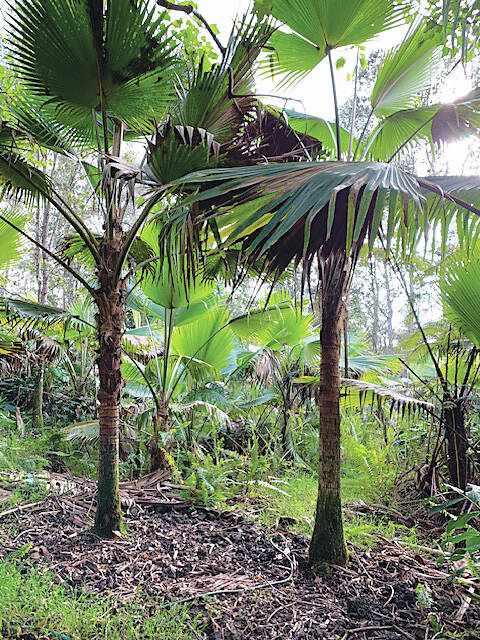Cloud forests, like the Kona Cloud Forest on the west side of Hawaii Island, are in jeopardy. Global warming is one culprit, and another is land clearing for development by landowners unaware of the impact forest destruction has on the eco-system and water-supplying aquifers. Trees produce oxygen, they supply shade, and sequester carbon that would contribute to global warming.
Many of Hawaii’s forests and watersheds are threatened, even with all the rhetoric about saving forests. In East Hawaii, many forest areas are subdivided into small lots of one to three acres. Unless the owners of the land commit to protecting the forested lots, they are often bulldozed and flattened.
In West Hawaii, the same situation is occurring with private lands being subdivided and cleared. One example in West Hawaii is the Kaloko Mauka subdivision that sits within the Kona Cloud Forest, where we are witnessing lots being subdivided and inadvertently bulldozed, sometimes without proper permits.
Much of Kaloko Mauka is still covered with native forest and remains sparsely populated. The area abounds with ancient ohia (Meterosideros polymorpha), ferns that may be over 100 years old, and rare and endangered species. It is the home of the Hawaiian hawk, apapane, iiwi, elepaio, amakihi and many other endemic and exotic birds, and it has been identified as an essential wildlife habitat and forest watershed. Many residents are committed to protecting this threatened eco-system, while some remain unaware of the devastating impact of deforestation.
Thankfully there are organizations working hard to make a difference through land management plans, education, conservation and reforestation. Bottom line, the cloud forest is essential if our island is to have the rainfall and watershed needed to supply water to communities at lower elevations.
County planners and organizations such as Moku o Keawe Land Conservancy (hecht.deb@gmail.com), The Nature Conservancy, Hawaii Land Trust, Outdoor Circle and many others are making an effort to encourage developers and residents to protect the forest through conservation easements and forest management plans. These programs allow landowners to dedicate portions of their land to native forest or tree crops, and for doing so they receive significant tax benefits. Some developers who are committed to forest protection are incorporating land stewardship into their development plans. They are paving the way for others to follow. There are a number of ways designate portions of a landowner’s property to forestry conservation and receive a tax benefit through the county.
Not only is it vital to protect our remaining forests, but to reforest those abandoned pasture and cane lands of Hamakua, Puna, Ka‘u and Kohala with biodiverse forests, thus ensuring valuable resources for future generations.
In the heart of the Kaloko Mauka subdivision, the Kona Cloud Forest Sanctuary has been providing educational tours, classes and workshops for nearly 40 years. It is a living classroom where people can learn about the important role of the cloud forest and the threat of human impact on this delicate ecosystem, while inspiring a greater level of respect and appreciation. Visit www.konacloudforest.com if you want to take a guided stroll through the cloud forest and learn more.
We may not be able to do much about other parts of the world, but here at home, you can be part of the solution or part of the problem. Let us all work together to raise awareness and create solutions.
For further information on forest planting and management, please contact University of Hawaii, College of Tropical Agriculture and Human Resources State Extension Forester, J.B. Friday at (808) 959-9155.
Norman Bezona is professor emeritus, University of Hawaii College of Tropical Agriculture and Human Resources.

